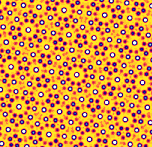

Quasi-crystalline materials are beautiful in more than one way - remarkably, they link together mathematics, crystallography, physics and materials science.
Roger Penrose, in his popular book on modern mathematics [1], describes his own involvement with research into aperiodic tilings of the plane. To many such a topic may seem not only trivial, but apparently rather useless.
The interested audience, which consisted of a select circle of mathematicians, widened dramatically in 1982, when Dan Shechtman [2] discovered a real material possessing precisely the sort of structure exhibited by the 'pentilings'! A typical diffraction pattern of such material clearly shows the 'prohibited' fivefold symmetry (see figure). This discovery led to a complete re-evaluation of our understanding of the crystalline state - so much so that in 1992 the International Union of Crystallography has published a new official definition of a crystal [3]:
"by crystal we mean any solid having an essentially discrete diffraction diagram..."In order for further practical implications and applications of quasi-crystals to be explored in full, mechanical behaviour of these systems must be investigated in some detail.
References